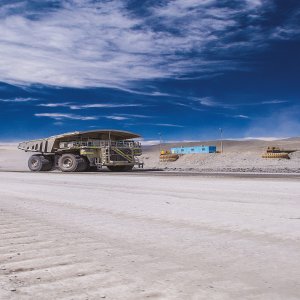Shine Returning to Traditional Mining State Guerrero

STORY INLINE POST
Q: How is the mining industry in Guerrero contributing to the state’s GDP and how does it benefit the local economy?
A: The official information we have indicates that in 2017 about MX$800 million of services and products were purchased from companies fiscally based in the state of Guerrero. That was basically a calculation of what Minera Media Luna and Los Filos spent, keeping in mind the former was blockaded for two months. We estimate that this year, Telson’s Campo Morado is spending about MX$30 million a month on services and products, half in the Arcelia region and half in Guerrero. Los Filos is spending about MX$80 million per month and Torex Gold is spending around MX$100 million per month. The numbers for this year could be well above MX$2 billion, which would far exceed our initial goal of MX$1.5 billion. In terms of direct employment and permanent contractors, the mining sector in Guerrero provides direct jobs to around 6,000-7,000 people. Multiplied by five or six mines, this equates to around 40,000 total direct and indirect jobs in the state. Assuming each of the workers provides for a family of four, mining is providing for around 200,000 people in the state. It also should be taken into consideration that mining jobs are the best-paid jobs in the region and among the best paid in the country. According to IMCO’s 2017 study, mining-related degrees are the fourth best paid professions in the country with an average salary above MX$17,000 a month plus benefits.
Q: What have been the Guerrero Cluster’s biggest achievements in the last year?
A: In 2018, we had a few ups and down in terms of mining operations. Minera Media Luna, the state’s largest operation and the country’s third largest gold mine, experienced an illegal blockade for several months, which distracted our attention. Although we were not working to our full capabilities, the main achievement was the strengthening of our value chain. We launched an ambitious value chain project together with CONCAINGRO. The cluster alongside CONCAINGRO has developed a technological platform that includes a directory of companies and their specifications. We are developing a registry of the needs of the mining companies to cross-reference. This is based on a national CONCAMIN platform and this really simplifies the process for many businesses.
In addition, as part of the change in the government and the 2018 elections, the Cluster’s Board held a meeting with the mayors-elect from the Guerrero gold belt and that was very important in terms of setting up a common agenda between the companies, the cluster and the communities through their mayoral representation. We want to create a common working group to develop the value chain and for the cluster to understand regional needs and areas where we can help. This will also help the mayors to understand the importance of the mining industry. The Cluster has also held meetings with the newly-elected members of the State Congress to openly discuss the benefits of mining for the region and make sure that public policy is aimed at making the environment more conducive to increased investment with a responsible focus.
Q: What steps is the cluster taking to bolster the competitiveness of the region’s mining companies?
A: The illegal blockade Minera Media Luna experienced from November to April was very helpful in making it clear that social license can almost never be granted without a strong local supplier base. Although Guerrero is not a traditional, industrialized mining state, with the large-scale projects that exist in Sonora, Chihuahua or other northern states. It has some of the most attractive opportunities and is a prolific and historical silver state that hosts Taxco.
Becoming a service provider for a company such as Minera Media Luna or Los Filos helps strengthen the national industry. These mines do not relax their requirements, expectations or the standards to which they work just because they are working with a local supplier. It is the responsibility of the local supplier to raise its standards to meet those of the international operator so it can continue working on the project. This motivates the national industry to adhere to higher standards and constantly improve its offering.
In this process of strengthening the value chain, we help existing companies meet the expectations of the mining industry as well as assisting those companies that want to set up operations in Guerrero. The business culture in Guerrero is at a different stage of development than that in Sonora or other states in the north. In Sonora or Monterrey, many companies are listed on the stock exchange, but in Guerrero there are many family-owned companies that are still working toward integration. We want to help them become competitive on a national scale and we will continue to work in collaboration with federal and state agencies to make sure our suppliers have access to all the programs that can help them develop into national and internationally competitive companies.
Q: What role does the Mining Fund play in the sustainable development of states such as Guerrero?
A: I believe the concept of the Mining Fund adheres to the concept of responsible mining, supporting local community development, whatever the established duty rate may be. It goes directly to the economic development of the region in which the mine is operating. But the issue of making the mining benefits available to the communities is extremely important to responsible mining. This allows miners to obtain social license to operate. Even with all the relevant permits from authorities, without the social license, the mine project simply cannot go ahead. It is important to ensure that the Mining Fund is transparent, that people are aware of the way it operates and the projects it is carrying out and that the projects selected should have a medium to long-term view. It is also important that the municipal authorities are aware of the fund’s distribution rules so greater institutionalization may be required in some cases.
Q: What have been the main advancements of your agreement with Sudbury, Canada?
A: With all the recent events, the establishing of the Technology Hub in Iguala was not a priority but right now it is a topic that greatly interests the new mayor-elect of Iguala. There are many companies from Sudbury that have been working with the mines in their underground operations and as such they are setting up shop in Iguala. We have continued promoting a joint collaboration with Sudbury and we are still working on the idea of a mining industrial shelter program in Iguala. I believe the municipality can be an example for the mining industry.
We are also working on an agreement between Sudbury’s Laurentian University, which is one of the leading universities in underground mineral exploration globally, and Universidad Español in Acapulco to create specialized training programs. The initially agreement will focus on four key areas, including environmental protection. We hope to have one of the first training programs released by the end of 2018.
Q: What would you suggest to the new administration to strengthen mining in Mexico?
A: We would request the same things we asked from Peña Nieto’s administration: a stable environment, rule of law and security and safety. This latter is still a massive issue even though thankfully the mining industry has not been as directly affected as others. Some companies, such as FEMSA-Coca Cola and Bimbo, have left the region because the level of security falls short of what is necessary for them to be able to operate reasonably. This is an issue that I think the administration must address urgently. We should look at reconstituting the institutional capabilities of security provision at a local level. The municipalities of Cocula and Iguala still do not have local municipal police but rather federal police acting on a contractual basis. But it is impossible to enforce the law without a centralized control mechanism.
Rule of law is also important because we cannot have situations like that at Minera Media Luna where the mine was illegally blockaded for two months. This is a billion-dollar project and the implications of this blockade were felt all the way down the value chain. While in this case, the mine paid its workers during the suspension of operations, it is entirely legal to suspend payroll, and this would have had a direct effect on the local community. It was at the discretion of Torex that salaries were paid.
There also needs to be a vision of transparency in fiscal matters. In some other jurisdictions, fiscal stability agreements ensure that a 30-year project will be charged fixed duties over the course of its life cycle. Unfortunately, I do not believe Mexico has a stable fiscal environment and we do not know what will happen from one administration to another. Right now, the US through President Trump’s reforms has reduced corporate tax to 20 percent, which makes Mexico even less competitive. As a long-term sector, miners need the government to show a long-term vision and fiscal stability.
























